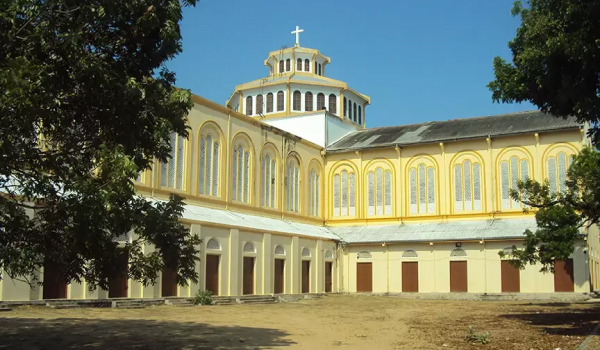
The diocese stretches over nearly 4,400 square kilometers. The population of this particular region is 1,533,000 of which 251,000 are Catholics. Most of the people are Hindus. The population of the whole country is 21.67 million.
Most people here speak Tamil. Many Muslims also take Tamil as their mother tongue.
Tamils are the second -largest ethnic group in Sri Lanka with prehistoric links to south India. This diocese has a number of Hindu temples including some ruined ones, some of which have been identified as Buddhist temples, and churches. Due to the nearness of South India and the influence of Hinduism, Indian culture is quite pervasive here.
The artistic excellence of Indian sculptures can be seen in many Hindu temples. Nallur, Keerimalai and Maviddapuram are some of them. When the Portuguese arrived in 1505, there were three kingdoms -- Kotte, Kandy and Jaffna. The Jaffna kingdom was last ruled by Ariyachakrawaththi Sangilian, a Hindu king. He vehemently opposed the spread of Christianity, and harassed and murdered many Christians. Historical records say that St. Francis Xavier visited Mannar and Jaffna in 1548 and persuaded Sangili to cease hostilities against Christians. The missionaries gradually won the admiration of the people because of their establishment of churches and schools. American missioners first landed in Jaffna city. They established many more missionary schools. Due to the high concentration of schools here, the city became renowned for education. Many upper-class families in Sri Lanka sent their children to Jaffna. Swami Arumuga Navalar, a Saivaite, and well-known for his literacy in Tamil and English, translated the Bible into Standard Tamil in the 1840s. Father Swaminathapillai Gnanapragasar, OMI, a scholar and a familiar name in Sri Lanka, served the underprivileged class from 1901-1947.
Kachativu, Palaitivu, Nainativu, Analaitivu, Mandativu Pungudutivu, (tivu means "island") are some of the main islands in the Jaffna diocese. There is the old St. Anthony's church in Kachativu. Every year Catholics from Sri Lanka and India gather here for a religious festival. In Nainativu, there are Buddhist Vihara and Hindu temples. However Christianity is often regarded as a Western religion. Tamils do not easily give up their ancient rites and traditions.
Diocese of Jaffna erected Sept. 1, 1886 Sri Lanka, which had formed part of the Archdiocese of Goa and the Diocese of Cochin for nearly 300 years, was made an apostolic vicariate on Dec. 3, 1834.
On Sept. 17, 1847 this Apostolic Vicariate of Ceylon was divided into two vicariates, namely Colombo and Jaffna. Monsignor Horace Bettachini, an Italian Oratorian, was appointed pro-Vicar Apostolic of Jaffna. On Aug. 13, 1849 he was confirmed Apostolic Vicar of Jaffna. He brought the Oblates of Mary Immaculate in 1948 to work in the vicariate.
Monsignor Stephen Semeria, OMI, became the next Apostolic Vicar of Jaffna when Monsignor Bettachini died in 1857. In 1886, when Colombo was made an archdiocese, Jaffna became a diocese and Monsignor Theophilus Andrew Melizan, OMI, became the first Bishop of Jaffna. The North Western province of the Diocese of Jaffna was later detached and joined to the Archdiocese of Colombo. In 1893, the Diocese of Trincomalee was created by carving up Jaffna diocese. The Apostolic Prefecture of Anuradhapura was later carved out from Jaffna diocese in 1975. The districts of Mannar and Vavuniya were detached from the Diocese of Jaffna to form the Diocese of Mannar in 1981. The patron saint of Jaffna diocese is Immaculate Mother of God.
Jaffna diocese has a generally dry climate although it gets monsoon rains from October to January. Most of the rain falls from November to February because of the northeast monsoon, which also results in cyclonic winds. The Bay of Bengal is choppy during this period. Dry zonal tanks collect and store water during this rainy season. The annual rainfall is between 1250 and 2000 mm. The average temperature here is between 27 and 31 degrees Celsius.
The diocese lies in the north of Sri Lanka and at the southern tip of India. The Jaffna peninsula, whose head protrudes into the sea, has archipelago in the Indian Ocean. In the southeast of the diocese, in the coastal plain, there are three main districts named Kilinochchi, Mullaitivu and Vavuniya which are famous for their thousands of agricultural tanks, fishing lakes, sanctuaries, pasture land for dairy farming, and forests.